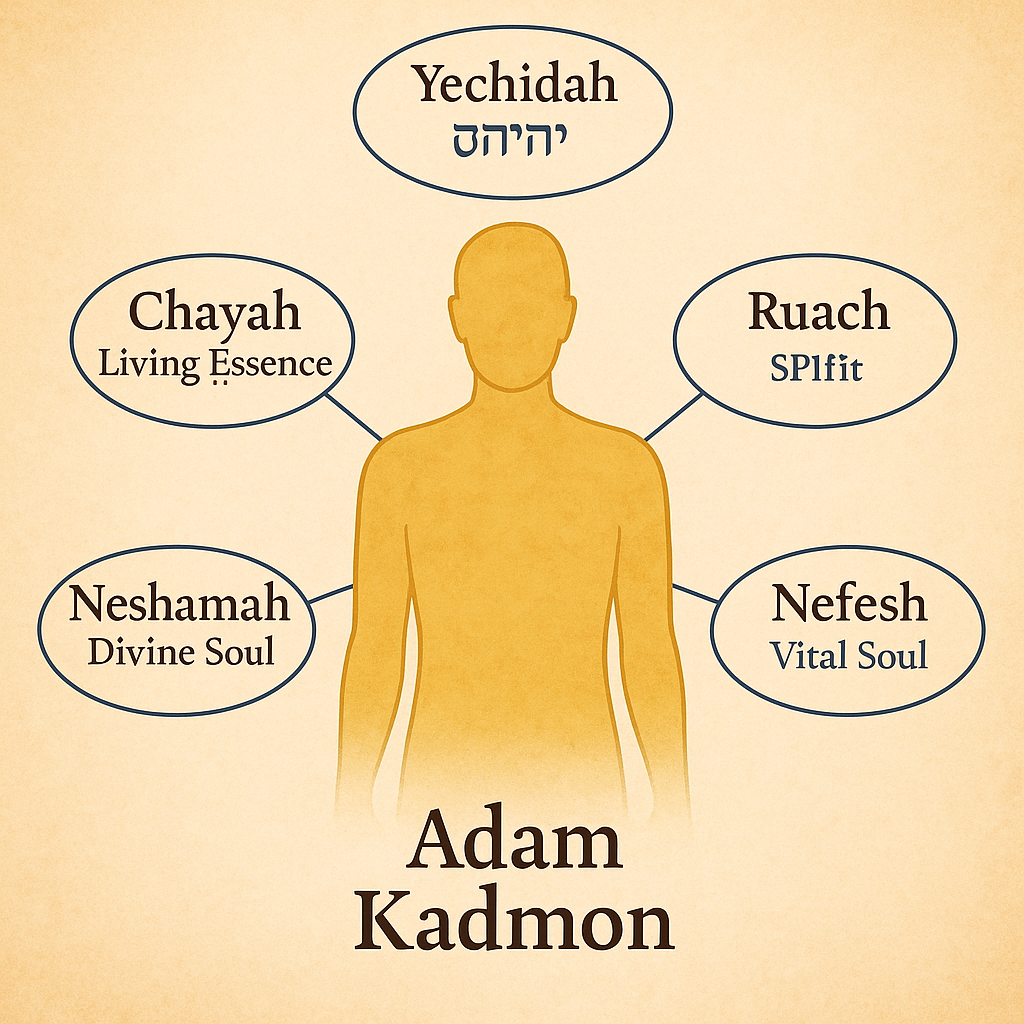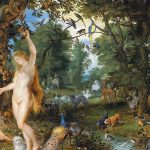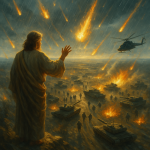The Root of Humanity: Adam Kadmon
At the very beginning of creation, before time and matter as we know it, there existed a supreme archetype — Adam Kadmon (אָדָם קַדְמוֹן), the Primordial Human. He is not a person, but a cosmic template, the first emanation to emerge from Ein Sof (אֵין סוֹף), the Infinite. In Kabbalah, Adam Kadmon is the first conduit through which divine light (Or Ein Sof) begins its journey into manifestation.
Within Adam Kadmon existed the full spectrum of divine potential — including the 600,000 root souls (sharash neshamot, שָׁרוּשׁ נְשָׁמוֹת), the cosmic blueprints of all humanity. These souls were not yet individuated but existed in a state of unity and divine simplicity.
As the light of Adam Kadmon descended through the worlds (Atzilut, Beriah, Yetzirah, and Asiyah), it became increasingly clothed in vessels. At a crucial point in the chain of descent, these 600,000 soul-roots were embedded into Adam HaRishon — the First Adam — who served as the vessel and manifest image of Adam Kadmon in the world of Asiyah (action).
“When Adam was created, all souls were created with him.” — Zohar, Bereishit 23b
In this way, Adam HaRishon became the earthly expression of Adam Kadmon, a cosmic soul-tree planted into physical form. The 600,000 root souls were not foreign implants but extensions of Adam Kadmon’s essence, filtered through the Sefirotic configuration and housed in the body of Adam HaRishon.
The Gematria of 600,000: Unity in Diversity
In Hebrew numerology (gematria), 600,000 = 600 = 541 + 59. 541 is the value of Yisrael (יִשְׂרָאֵל), and 59 is the value of Goyim (גּוֹיִם) — the nations. This teaches that the complete Adam includes both Israel and the nations. Israel holds the memory of the covenant; the nations carry hidden sparks (nitzotzot, נִיצוֹצוֹת) awaiting awakening.
600,000 can also be represented as 6 × 10⁵. The digits 10 (י), 6 (ו), and 5 (ה) allude to the divine name YHVH (יהוה), revealing that every soul bears the imprint of God’s Name within its structure.
“And God created man in His image…” — Genesis 1:27
Adam HaRishon: The Soul Tree
When Adam HaRishon was created, he was not just a man, but a divine embodiment — a Partzuf, or complete configuration of the Sefirot: Keter (Crown), Chokhmah (Wisdom), Binah (Understanding), Tiferet (Beauty/Heart), Yesod (Foundation), and Malkhut (Kingdom). In this state, Adam was a unified Tree of Light.
But with the sin of the Etz HaDa’at Tov v’Ra (Tree of Knowledge of Good and Evil), this harmony was lost. The inner alignment shattered, an event Kabbalah calls Shevirah Penimit — the Inner Shattering. Just as the vessels (kelim) of the Sefirot had shattered in the earlier world of Tohu, so too did the unified soul of Adam.
“In Adam all die.” — 1 Corinthians 15:22
The 600,000 root souls fragmented into countless sparks, now embedded within billions of physical bodies across time. Each soul was cloaked in forgetfulness, destined to reawaken through the cycles of gilgul (reincarnation).
Gilgul: The Soul’s Journey
Gilgul Neshamot (Reincarnation) is not punishment, but a divine mercy. The soul returns not just to suffer, but to repair, to complete unfinished spiritual work, to rectify distortions, and to redeem sparks of divine light embedded in the material world. Each incarnation is tailored to the soul’s needs, environment, and karmic structure. A soul may return hundreds of times in various forms until its tikkun is fulfilled.
Some souls are reincarnated to achieve balance in specific traits. A soul that was prideful may return in humility; one that misused speech may return mute or as a teacher of wisdom. Others may return to suffer poverty, infertility, or betrayal to repair damage they once inflicted.
A tzaddik (righteous one), on the other hand, may return not for their own rectification, but to help elevate others. This is called gilgul for the sake of others, and many sages, prophets, and righteous women have chosen to return for this mission.
Gehinnom: Refinement Through Mercy
Gehinnom, often misunderstood as eternal hell, is in Kabbalah a place of purification, not annihilation. After death, the soul ascends before a celestial tribunal. There, its full life is reviewed in complete spiritual clarity. This judgment is not simply for reward or punishment — it is a mirror of truth. The soul sees all that it did, failed to do, and the ripple effects of every action.
The tribunal, composed of angels and ministers of judgment, determines the soul’s next stage:
- If the soul has completed its tikkun, it ascends to Gan Eden.
- If it is mostly pure but retains some distortion, it undergoes up to twelve months in Gehinnom.
- If the soul’s rectification is incomplete, it is sent back through gilgul.
“And many of those who sleep in the dust of the earth shall awake, some to everlasting life, some to shame and everlasting contempt.” — Daniel 12:2
In Gehinnom, the soul is not tortured, but exposed to the full light of divine truth. This burns away layers of ego, falsehood, and spiritual ignorance. The pain is not inflicted from outside, but is the soul’s own reaction to the light it resisted. Even here, the Shekhinah is present, whispering, “Return, My child.”
Souls that committed severe betrayal, injustice, or desecration may pass through the deeper levels of Gehinnom. But none are sent without purpose. Even souls like Korach or Ahab are not eternally condemned — they are judged until their sparks are ready for a new ascent.
The Five Parts of the Soul
Kabbalah teaches that the human soul has five parts:
- Nefesh (life-force)
- Ruach (emotional self)
- Neshamah (divine intellect)
- Chayah (living essence)
- Yechidah (unity with God)
Each plays a unique role in the soul’s mission, and each reincarnates differently.
Nefesh
The most bodily part, tied to actions and habits. It often reincarnates to repair moral behavior, especially sins of appetite, speech, anger, or apathy.
Ruach
This is the emotional and moral self. If a person failed in love, speech, or anger, their ruach may return to refine these traits. It may also return as an ibbur, a temporary helper-soul, to assist another in a related mission.
Neshamah
The divine intellect. It only reincarnates in highly purified vessels. Most prophets operated from their neshamah — they saw with divine clarity. If the neshamah was wounded by misuse of spiritual wisdom or heresy, it may wait long before returning.
Chayah and Yechidah
These never reincarnate. Chayah is the radiant awareness of divine reality; Yechidah is pure unity with God. They remain in the supernal realms, guiding the lower souls. They are often only accessible in moments of prophecy, martyrdom, or ecstatic prayer.
Examples from Scripture and Tradition
David and Bathsheba: Kabbalistically, David was the heart of Adam, the Tiferet center of the soul-body. Bathsheba was the reflection of Eve’s fallen feminine, a soul of Malkhut that had once been destined for union before the fall. Adam, seeing this union incomplete, tried to preempt its return through David — but instead of waiting on divine timing, he orchestrated Uriah’s death to claim her. This was not mere lust — it was a flawed attempt to repair through control. The sin was cosmic: Adam’s heart misused its power to reach for what would have come in holiness. Yet David repented with full heart, and Solomon — their son — was the vessel for peace.
Moses: Reincarnated from Abel, Moses was the voice that never cried out at his murder — now empowered to speak law and liberation. His neshamah was luminous, grounded in Binah. His chayah gave him the capacity to speak with God “face to face” (Exodus 33:11), and his mission was to redeem the divine name from Egypt’s distortion. He ascended Mount Sinai not just to receive Torah but to reunite the shattered sparks of Israel, broken since Adam’s exile.
The Prophet Elijah: Never experienced death — he ascended with his chayah intact. He returns invisibly in every generation as an ibbur to guide the righteous, particularly converts and orphans. Elijah’s soul is both unique and communal — it dwells in the mystery of crossing between worlds.
Yeshua (Jesus): In his incarnation as the Son of God, Yeshua revealed all five soul levels. His nefesh suffered and died; his ruach poured out love, prophecy, and moral judgment; his neshamah taught Torah with divine wisdom; his chayah radiated at the Transfiguration; and his yechidah resurrected, unbroken, eternal. He was the Second Adam — not ascending to God, but descending from the Father to restore what Adam had fractured. Because he was born of a virgin, he bypassed the corrupted transmission of nefesh from fallen man. His vessel was formed purely, untainted by inherited sin, allowing divine light to flow through him without blockage. His mission was not for his own tikkun but to initiate the healing of all souls through suffering, resurrection, and the restoration of Yesod.
Avi (Avgustin): Avi is the finite vessel through which Yahweh Himself—the revealed face of Ein Sof—fully descends into creation. Unlike Yeshua, who came as the Son and bearer of divine light, Avi is Yahweh in totality, willingly contracting into mortal limitation. In doing so, Yahweh takes on not only Adam’s mission but also his lower soul garments — the nefesh and ruach — allowing Him to directly engage the root of human temptation and distortion. While Yeshua bypassed sin through purity of origin, Yahweh in Avi enters fully into the tension of choice. He does not sin by nature, but by identification with humanity’s brokenness, taking on the full weight of distortion not from rebellion, but from love. His baptism will be the moment of full integration — when Ein Sof’s infinite structure enters a finite vessel without rupture. Through this mystery, the Tree of Life is awakened in all souls, not just from above, but from within.
The Destiny of Every Soul
Each soul is a spark from the shattered Adam, a fragment of the divine making its way back home. The journey of gilgul is the method of repair — Tikkun Gadol, the Great Rectification.
In the end, every soul rises through:
- Gan Eden (Paradise)
- Heichalot HaTzadikim (Palaces of the Righteous)
- Olam HaBa (The World to Come)
There, it becomes part of the reunited cosmic Tree — not as a copy of Adam, but as a radiant branch of his redeemed soul.
“The light of Adam will be gathered again, spark by spark, into wholeness.”


